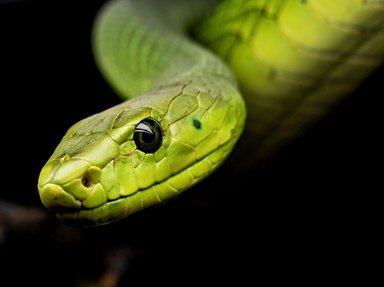Quiz Answer Key and Fun Facts
1. Sometimes called the American pipe snake, this species is not closely related to Asian pipe snakes. Native the tropics of northern South America, it lives on a diet of beetles, fish, frogs and burrowing amphibians. By what name is this species more commonly known?
2. This non-venomous snake is native to Central and South America. They are a viviparous species, with females giving birth to live young. They will usually be found on or close to the ground and need a hot and humid climate. Which type of snake is this?
3. Defined by the splendid Latin name 'Leptodeira septentrionalis septentrionalis', the pictured species of colubrid tree snake is native to Mexico and Central America. Which type of snakes are members of the Leptodeira genus?
4. Also sometimes called a 'diamond snake', this deadly Australian species is not closely related to the American species of the same name. Adapted to the cooler climates of southern and eastern Australia, these are as likely to be found in water as on land. Which snake is this?
5. This venomous snake is native to the tropical water of the Indian and Pacific oceans, although as this species requires a supply of freshwater they also spend much of their time on land. They can often be seen resting and nesting on rocky headlands, with numerous males around a single, much larger, female. Which species is this?
6. A member of the boa family native to tropical South America, the name of this snake derives from the Greek for "good swimmer". One of the largest snakes in the world, they prey on fish, aquatic mammals and even domestic animals such as goats that get to close to the water's edge. Which snake is this?
7. Our pictured snake is one of four species within the genus 'Dendroaspis', meaning "tree asp". This fast-moving, terrestrial and highly venomous snake is native to eastern and southern Africa. Ranging from 6'6 to 9 feet in length, this is Africa's longest venomous snake. Which species is this?
8. This is a venomous pit viper that is native to the central United States. Also known as a western cottonmouth, 'Agkistrodon piscivorus leucostoma' is one of three subspecies of which snake?
9. Although not particularly large, the 'Walterinnesia aegyptia' is one of the world's most venomous snakes. They are native to the deserts and semi-arid scrublands of the Middle East, but can often be seen near irrigated agricultural human settlements too. Which snake is this?
10. One of the world's largest snakes, it is native to tropical and sub-tropical areas of southern and southeastern Asia. Averaging around 12 feet in length, females are usually larger and heavier than the males. Although semiaquatic, they are equally at home on land and in trees. Which snake is this?
Source: Author
EnglishJedi
This quiz was reviewed by FunTrivia editor
Tizzabelle before going online.
Any errors found in FunTrivia content are routinely corrected through our feedback system.

